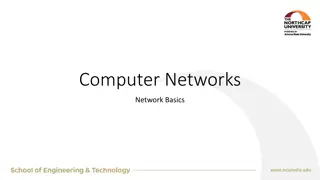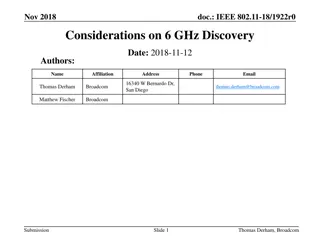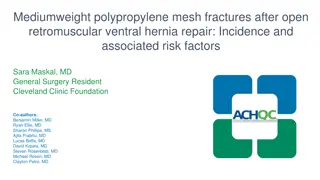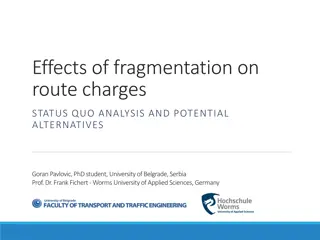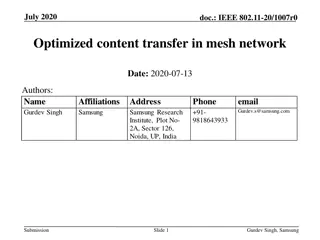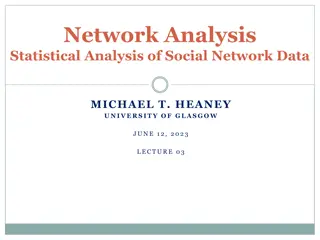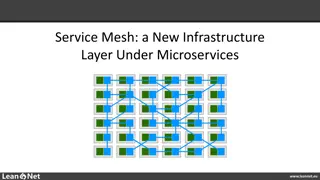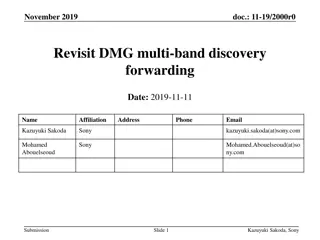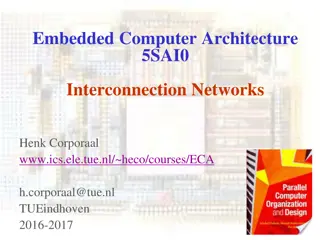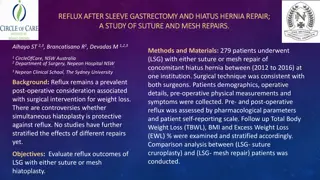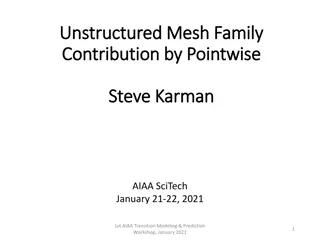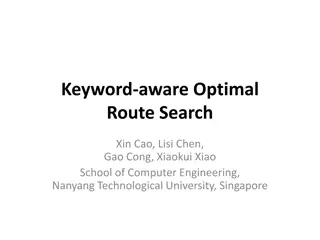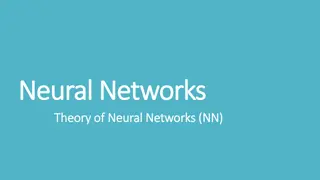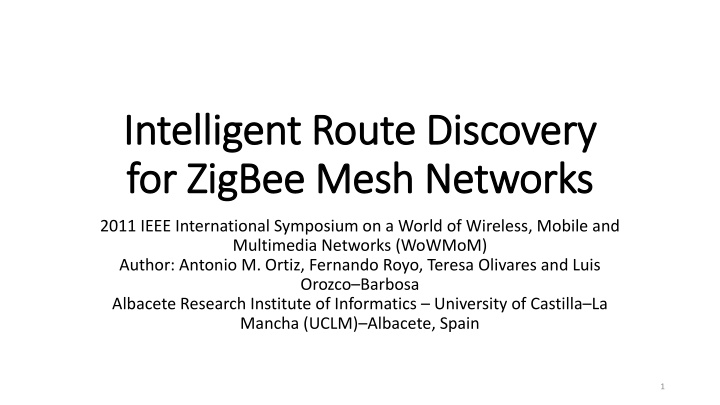
Intelligent Route Discovery for ZigBee Mesh Networks
Explore a novel fuzzy logic-based metric proposed for improving the AODV routing protocol in ZigBee mesh networks, addressing issues like high overhead and inefficient energy usage. Discover how this innovative approach optimizes route creation for enhanced network performance.
Uploaded on | 0 Views
Download Presentation

Please find below an Image/Link to download the presentation.
The content on the website is provided AS IS for your information and personal use only. It may not be sold, licensed, or shared on other websites without obtaining consent from the author. If you encounter any issues during the download, it is possible that the publisher has removed the file from their server.
You are allowed to download the files provided on this website for personal or commercial use, subject to the condition that they are used lawfully. All files are the property of their respective owners.
The content on the website is provided AS IS for your information and personal use only. It may not be sold, licensed, or shared on other websites without obtaining consent from the author.
E N D
Presentation Transcript
Intelligent Route Discovery Intelligent Route Discovery for for ZigBee ZigBee Mesh Networks Mesh Networks 2011 IEEE International Symposium on a World of Wireless, Mobile and Multimedia Networks (WoWMoM) Author: Antonio M. Ortiz, Fernando Royo, Teresa Olivares and Luis Orozco Barbosa Albacete Research Institute of Informatics University of Castilla La Mancha (UCLM) Albacete, Spain 1
Introduction Introduction The routing protocol for ZigBee mesh networks is AODV, an on- demand routing protocol which has been extensively used. However, it presents critical problems when it is used in large dense networks, mainly related to the high number of messages necessary to perform routing tasks, which causes a very high overhead. 2
Introduction Introduction This study proposes the use of a novel fuzzy logic based metric to be used in the decision making process of AODV. This metric evaluates important node features during route creation and selects, hop by hop, the best option in order to obtain energy and delay efficient routes. 3
Ad Ad- -hoc On Demand Distance Vector (AODV) hoc On Demand Distance Vector (AODV) routing routing D 1 4 S 7 2 5 RREQ(Route Request) 3 6 4
Ad Ad- -hoc On Demand Distance Vector (AODV) hoc On Demand Distance Vector (AODV) routing routing D 1 4 S 7 2 5 RREQ(Route Request) 3 RREP(Route Reply) 6 5
AODV drawbacks AODV drawbacks 1. Packet overhead 2. Redundant discovery 3. High route discovery delay 4. High memory demand 5. Duplicated messages 6. Deficient metric 6
Fuzzy Logic Fuzzy Logic( ( ) ) : 7
Fuzzy Logic Fuzzy Logic( ( ) ) 8
Fuzzy Logic Fuzzy Logic( ( ) ) 26 ( 0.66 0.33) 28 ( ) ( 0.66 1.33) 23 ( ) 28 ( ) ( 1 1) 29 ( 0.66 0.33) 31 ( ) ( 0.66 1.33) 9
AODV AODV- -FL(AODV FL(AODV with Fuzzy with Fuzzy Logic) Logic) 10
AODV AODV- -FL(AODV FL(AODV with Fuzzy with Fuzzy Logic) Logic) 11
AODV AODV- -FL(AODV with Fuzzy Logic) FL(AODV with Fuzzy Logic) 1.Low High Med D 1 2.Med Med High 4 S 7 2 5 RREQ(Route Request) 3 6 12
AODV AODV- -FL(AODV with Fuzzy Logic) FL(AODV with Fuzzy Logic) D 1 4 S 7 2 5 RREQ(Route Request) 3 RREP(Route Reply) 6 13
Experiment(Energy) Experiment(Energy) 14
Experiment(Total Packets) Experiment(Total Packets) 15
Experiment(RREQ Packet) Experiment(RREQ Packet) 16
Experiment(End Experiment(End- -to to- -End End D Delay) elay) 17
Experiment(Hops) Experiment(Hops) 18
Conclusions Conclusions This paper proposes the use of a fuzzy-logic-based metric to evaluate node conditions in AODV protocol in order to select better-state nodes to be part of routes. Moreover, in contrast to other proposals, the fuzzy-logic-based system does not require additional memory or computational costs, and does not imply an extra load for network nodes, allowing a global performance improvement of the route discovery process in mesh WSNs. 19
Future Work Future Work All these results endorse the suitability of AODV-FL to be implemented in a real wireless sensor network. Our future plans consider the experiments of AODV-FL in networks with mobile nodes, where we aim to obtain similar improvements in network performance. 20
Reference (1999-07-23) 21

